Famous People Buried in Westminster Abbey- The Legendary Burials at Westminster Abbey
Purchases made through links earn us a small commission, at no extra cost to you.
Westminster Abbey is not only England’s most distinguished church, regularly hosting national celebrations and royal events, but it’s also one of the world’s most esteemed mausoleums.
Many of Britain’s illustrious figures are buried in Westminster Abbey, some in grand tombs and others under simple stones in the floor. Here’s a look at some of the famous people buried in Westminster Abbey and their legacies.
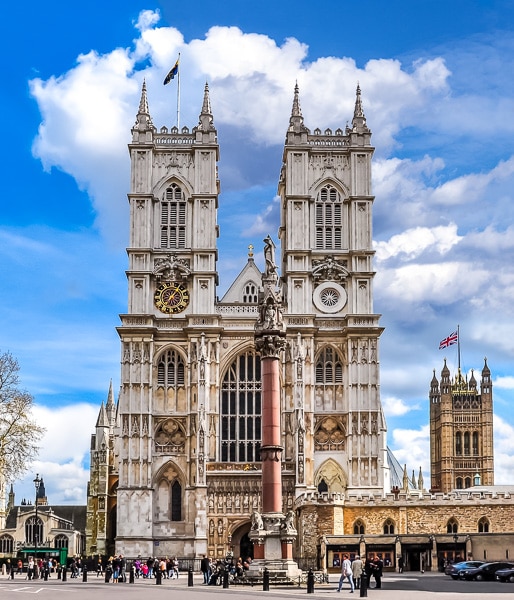
In This Post
Westminster Abbey Burials- Who is Buried at Westminster Abbey?
Westminster Abbey has been used as a place of burial for generations, starting with the entombment of King Edward the Confessor in the 11th century. For much of this long tradition, most people buried in Westminster Abbey were monarchs and people with a connection to the church, such as those who worked or attended services there.
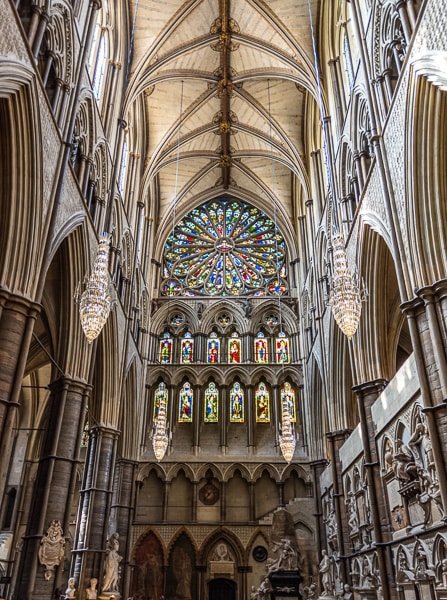
In the 17th century, the abbey started to be used as a burial place for national figures who weren’t royalty. Soon it was considered a prestigious honour to be laid to rest in Westminster Abbey and generals, scientists, explorers, politicians, doctors, architects, writers, actors, and musicians were buried among the kings, queens, and priests.
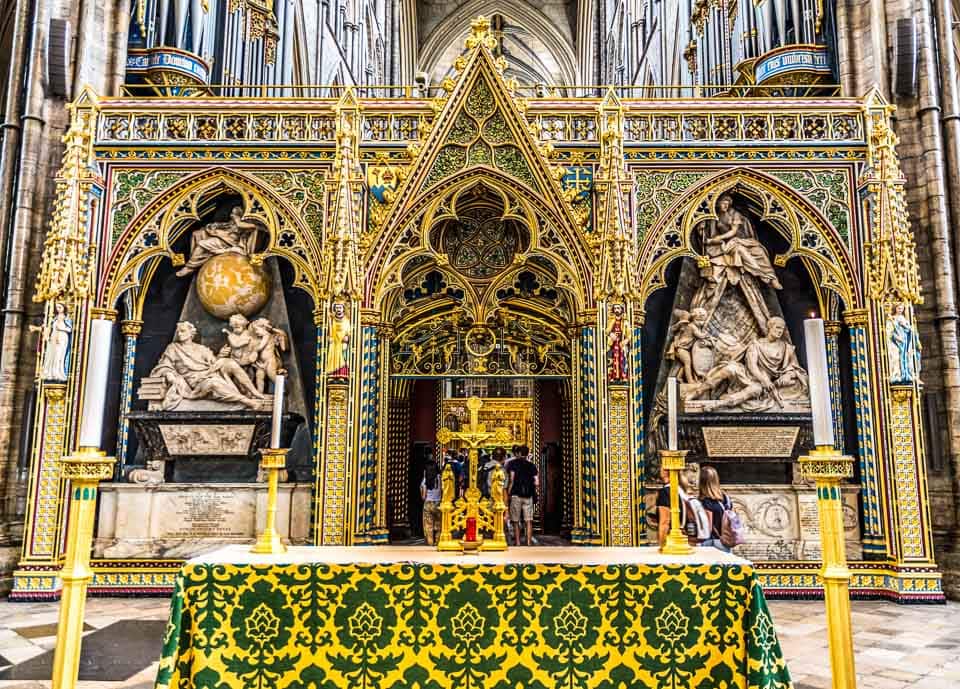
Westminster Abbey is especially renowned for its Poets’ Corner in the south transept where more than 100 poets and writers are buried or have memorials.
There are now about 3,300 burials in Westminster Abbey and several monuments for prominent figures that are buried elsewhere. Due to a lack of space in the abbey, most burials now are of cremated remains.
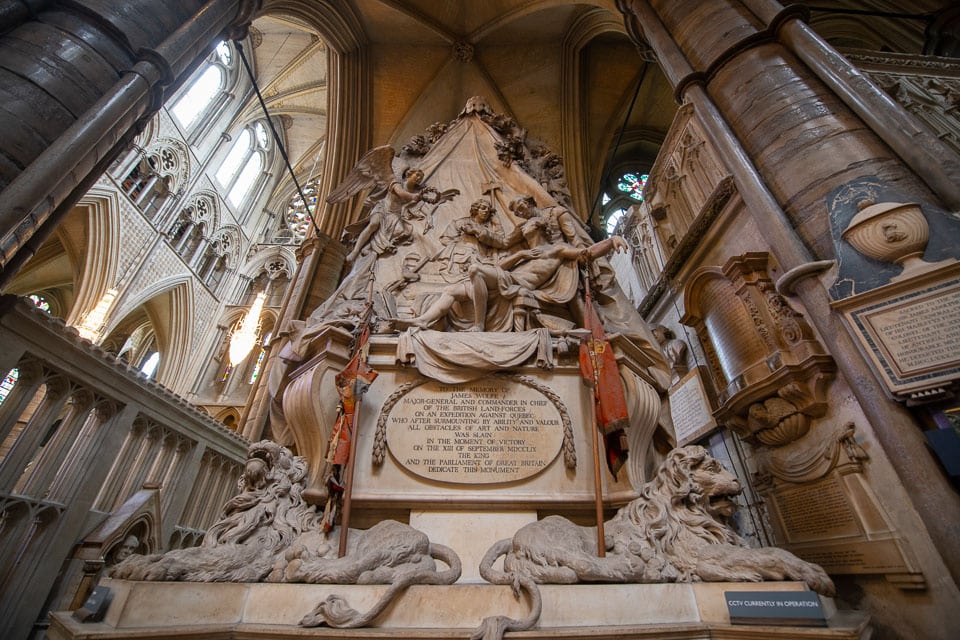
Famous People Buried in Westminster Abbey
Below are some of the famous people buried in Westminster Abbey including a summary of their accomplishments and a description of their grave.
We haven’t included monarchs and other royals on this list of burials in Westminster Abbey because there are so many that they deserve their own post. Here is where you can read more about Westminster Abbey’s royal tombs.
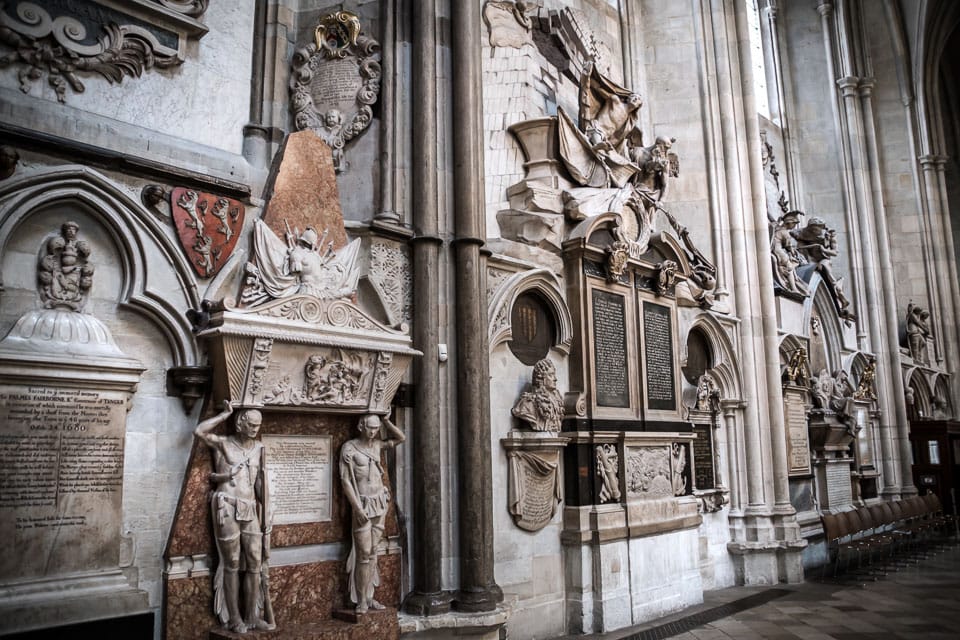
Sir Isaac Newton
Burial: Nave
Sir Isaac Newton was a scientist, mathematician and astronomer. He made many discoveries and inventions including the law of universal gravitation, the law of motion, calculus, and the reflecting telescope. He is often regarded as one of the most influential scientists in history.
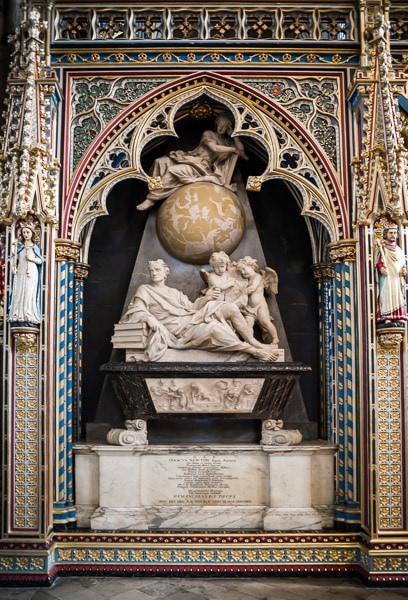
After dying in 1727, Newton was buried in Westminster Abbey. He was the first scientist to be included in the burials at Westminster Abbey. Near his grave is a stunning monument honouring Newton that features a sarcophagus with a relief panel, a reclining sculpture of Newton with his books, and a celestial globe on which sits a figure of Urania, the muse of Astronomy.
Charles Darwin
Burial: Nave
Charles Darwin was a naturalist, biologist, and geologist who devised the theory of evolution and the theory of natural selection. His observations and theories about evolutionary biology were published in his books The Voyage of the Beagle, On the Origin of Species, and The Descent of Man, gaining him recognition as an author.
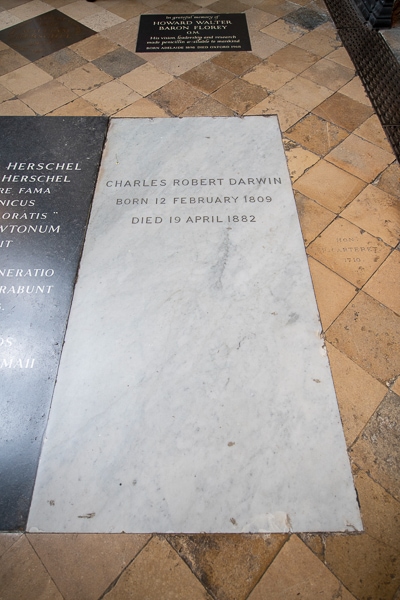
Darwin died in 1882 and, upon request of his colleagues, was buried at Westminster Abbey. His grave is in the north aisle of the nave next to the grave of scientist Sir John Herschel. A Carrara marble stone engraved with his name and dates of birth and death marks his resting place and a memorial bronze medallion was erected nearby in the north choir aisle.
Stephen Hawking
Burial: Nave
Accomplished physicist and author Stephen Hawking worked in the fields of general relativity and quantum gravity, authoring a best-selling book about cosmology titled A Brief History of Time: From the Big Bang to Black Holes. His work garnered several prestigious awards including the Presidential Medal of Freedom bestowed by the President of the United States.
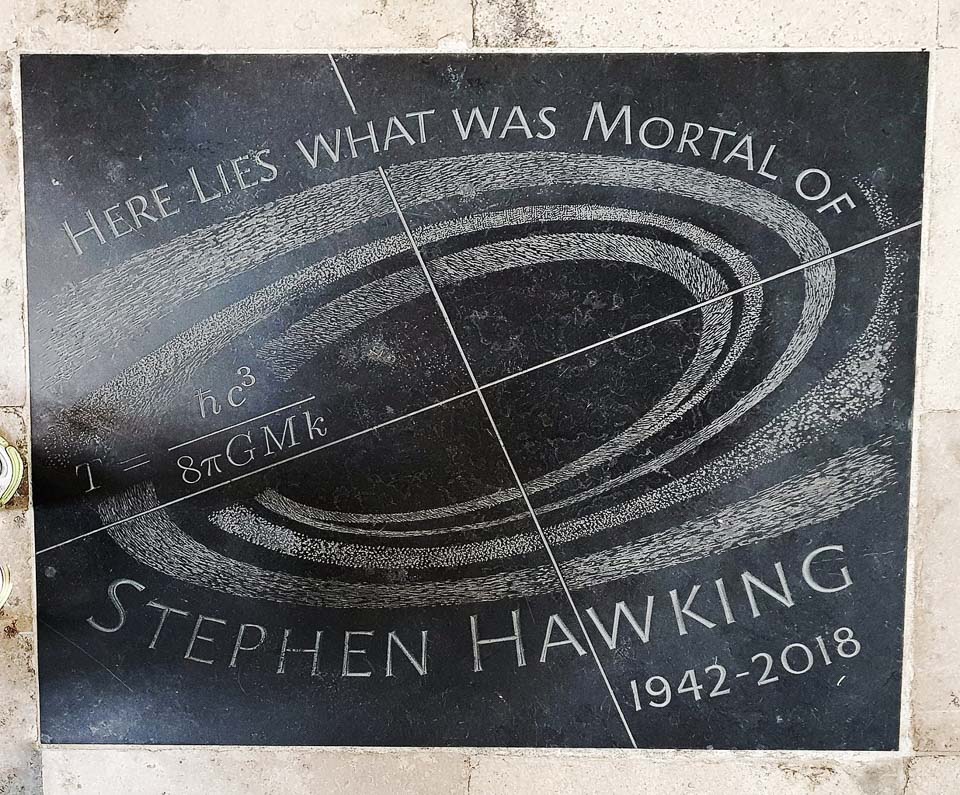
Hawking died at the age of 76 after living over 50 years with motor neurone disease. His ashes were interred in the nave of Westminster Abbey near the graves of Charles Darwin and Sir Isaac Newton. His slate memorial stone is inscribed with his most famed equation, a depiction of rings surrounding a central ellipse, and the words: Here lies what was mortal of Stephen Hawking.
Sir Joseph John Thomson
Burial: Nave
Physicist Sir Joseph John Thomson discovered the electron, marking the beginning of modern atomic physics. He was awarded the Nobel Prize for Physics in 1906 for his work on the conduction of electricity in gases. He is also credited with discovering evidence of isotopes.
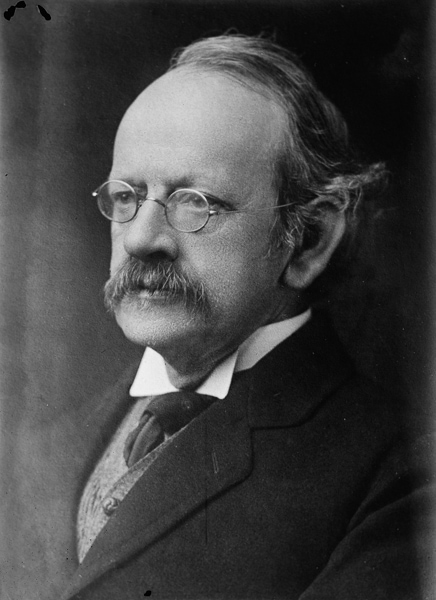
Thomson died in 1940 and his ashes were buried in Westminster Abbey during his funeral service. His memorial stone reads in part: Order of merit. Physicist. Master of Trinity College Cambridge.
George Frederic Handel
Burial: South Transept
Composer George Frederick Handel was known for his Italian operas, English oratorios, and organ concertos. He composed for many patrons and occasions, including writing four anthems for the coronation of George II, one of which has been used at every coronation since. Handel is regarded as one of the greatest composers of his time.
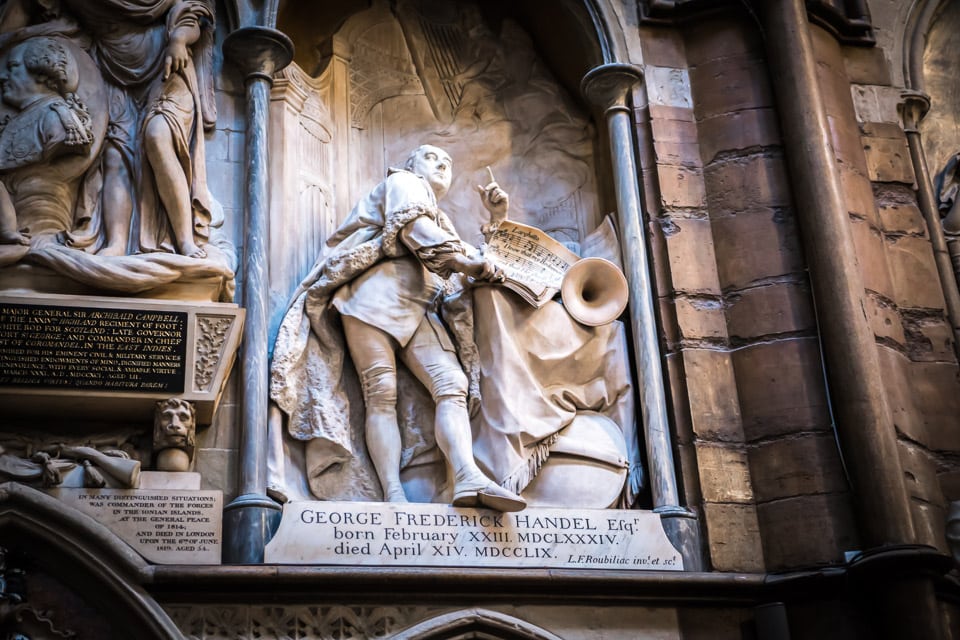
After his death in 1759, Handel was given a state funeral at Westminster Abbey. Per his wishes, he was buried in the abbey and a monument was also erected. His black marble gravestone has a worn coat of arms and the monument on the wall above features a statue of his likeness with a score of his oratorio Messiah.
Geoffrey Chaucer
Burial: Poets’ Corner
Geoffrey Chaucer was a civil servant, author, and poet who has been called “The Father of English Poetry”. His best-known work is The Canterbury Tales.
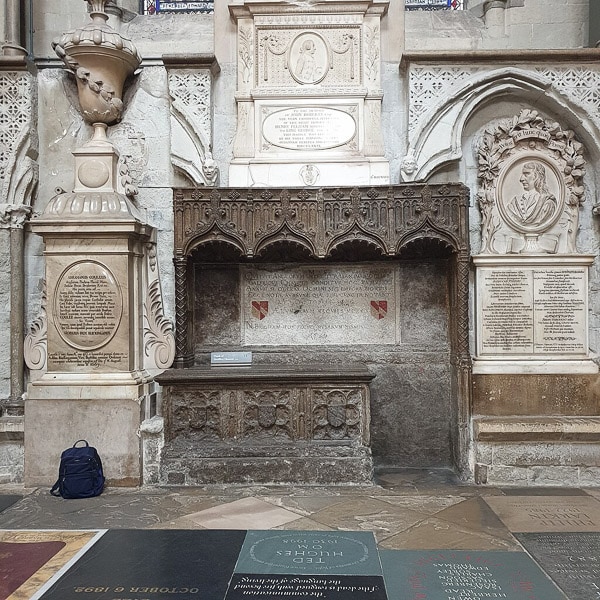
Chaucer was the first poet to be buried in what has since become Poets’ Corner in the South Transept of the abbey. Chaucer’s tomb in Westminster Abbey is made out of grey Purbeck marble and features two paintings of his coat of arms and a poetic Latin inscription.
Charles Dickens
Burial: Poets’ Corner
One of the most famous writers among the Westminster Abbey burials is English novelist Charles Dickens. His first major literary success was The Pickwick Papers followed by the now classics Oliver Twist, A Christmas Carol, A Tale of Two Cities, and Great Expectations. Dickens created some of the most memorable characters in literature and is often regarded as the Victorian era’s greatest novelist.
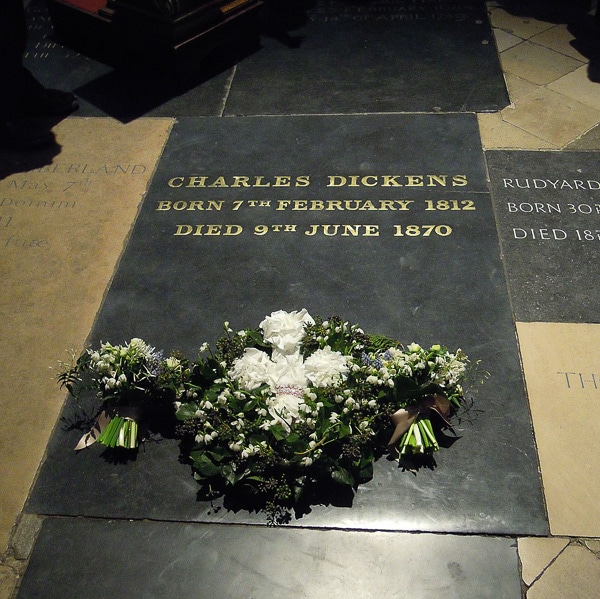
After dying of a stroke in 1870, Dickens was laid to rest in Westminster Abbey. His grave in Poets’ Corner is marked by a stone in the floor inscribed with his name and dates of birth and death in gold lettering. Each year on his birthday a wreath is laid on his grave.
Robert Browning
Burial: Poets’ Corner
Poet and playwright Robert Browning was known for his dramatic monologues and social commentary. Some of his notable works include the epic poem The Ring and the Book and the poetry collection Men and Women.
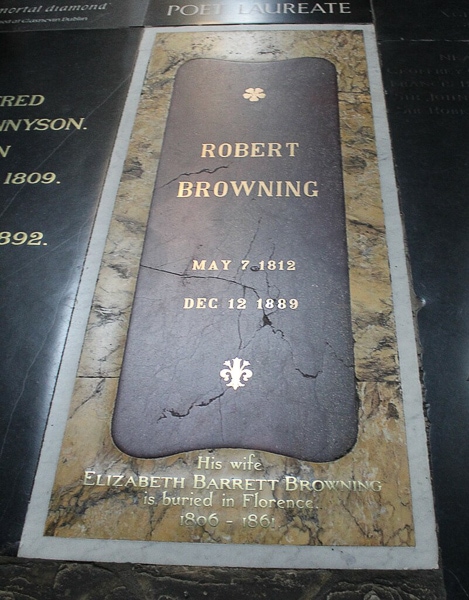
Browning died in Venice in 1889 and was later buried in the Poets’ Corner of Westminster Abbey. His gravestone is made of porphyry and yellow Sienese Italian marble and features emblems of a lily and a rose.
Alfred, Lord Tennyson
Burial: Poets’ Corner
Alfred, Lord Tennyson was a celebrated poet in the 1800s. He was awarded the Chancellor’s Gold Medal at Cambridge University for “Timbuktu” and was appointed Poet Laureate during the reign of Queen Victoria, serving the longest tenure of any laureate. Influenced by the Romantic poets, his poetry was known for its rhythmic and musical qualities.
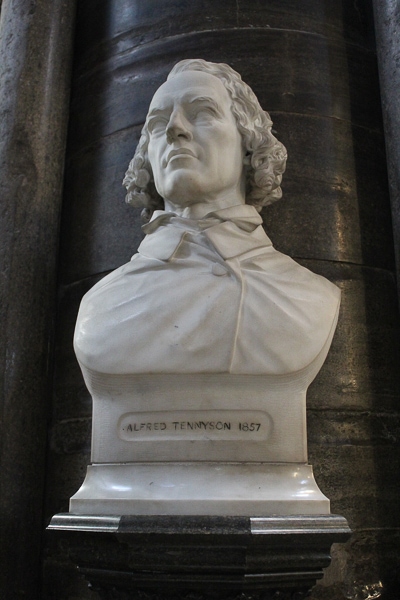
Tennyson died in 1892 at the age of 83 and was buried in Westminster Abbey after his funeral. His gravestone in Poets’ Corner reads: Alfred, Lord Tennyson. Born August 6, 1809. Died October 6, 1892.
Rudyard Kipling
Burial: Poets’ Corner
Nobel Prize recipient Rudyard Kipling was an author of novels, short stories, children’s books, and poems. As one of the United Kingdom’s best-known writers in the late 1800s and early 1900s, he produced many notable works in several genres including children’s literature The Jungle Book and Just So Stories, the short story “The Man Who Would Be King”, and the poems “If” and “Mandalay”.
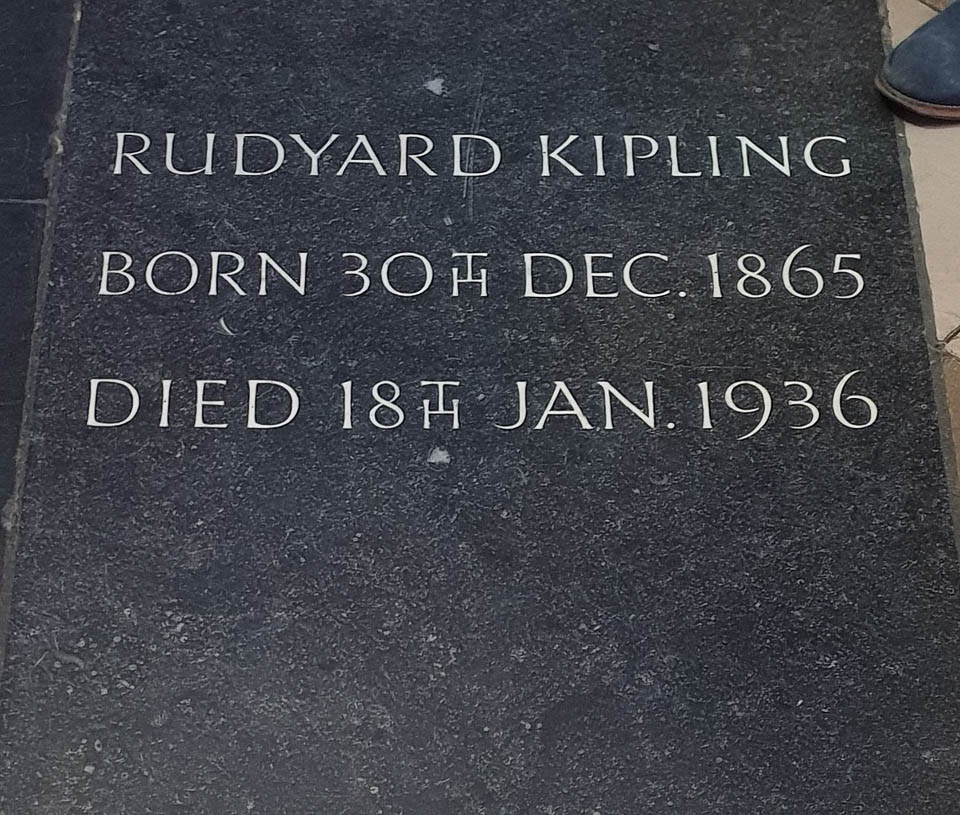
After his death in 1936, Kipling’s ashes were interred at Westminster Abbey in Poets’ Corner beside the grave of Charles Dickens. Kipling’s grave is marked by a simple stone in the floor inscribed with his dates of birth and death.
Thomas Hardy
Burial: Poets’ Corner
Thomas Hardy was a poet and novelist who was known for incorporating criticism of the beliefs and social constraints of Victorian society into his works. A few of his notable novels include Far from the Madding Crowd, Tess of the d’Urbervilles, and The Mayor of Casterbridge.
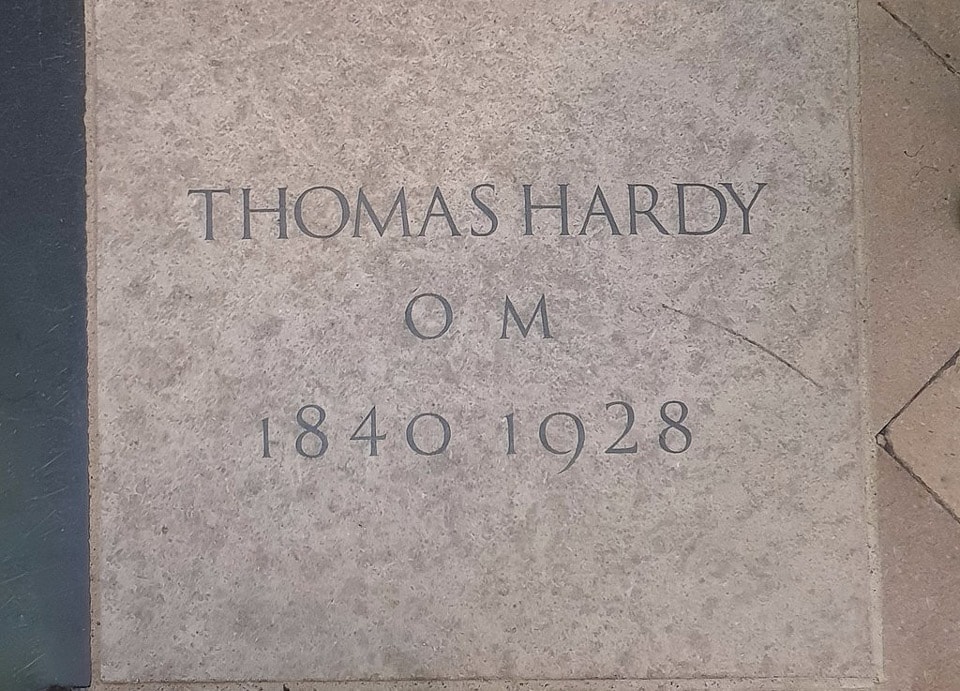
Hardy’s ashes were interred in Poets’ Corner after his death in 1928, but his heart was buried at Stinsford in the grave of his first wife. Hardy’s grave in Westminster Abbey is marked with a small, tan-coloured stone in the floor beside the graves of Charles Dickens and Rudyard Kipling.
Benjamin Jonson
Burial: Nave
Benjamin Jonson was a playwright, poet, and actor. He is known for his satirical plays and for popularizing the comedy of humours, a genre of dramatic comedy.
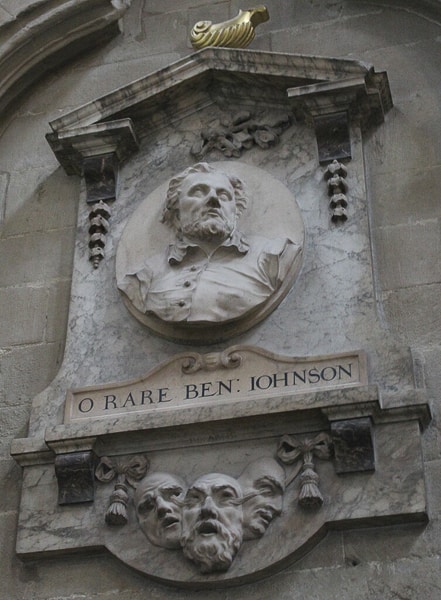
Interestingly, Jonson is the only person buried in Westminster Abbey standing in an upright position. The small grey lozenge stone marking his grave isn’t the original gravestone- that was moved in the 19th century to the base of the wall opposite his grave. Both stones are inscribed with: O Rare Ben Johnson. A monument honouring Jonson was also erected in the eastern aisle of Poets’ Corner.
Laurence Olivier
Burial: South Transept
Laurence Olivier was an English actor who portrayed characters on stage and in film and television. Some of his best-known screen roles were as Heathcliff in Wuthering Heights, Maxim de Winter in Rebecca, and Hamlet in the 1948 film Hamlet. He received several Academy Award nominations for his portrayals, taking home two Oscars.
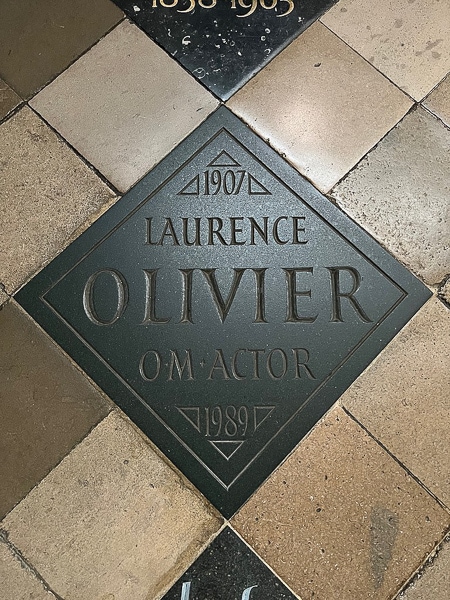
Olivier died of kidney failure in 1989. After his cremation and memorial service, he was buried in Westminster Abbey under a stone of Westmorland green slate.
David Livingstone
Burial: Nave
David Livingstone was a doctor, missionary, and explorer who worked in Africa. His expeditions focused on exploring the central African watershed. He recorded his accomplishments in his 1857 book Missionary Travels and Researches in South Africa.
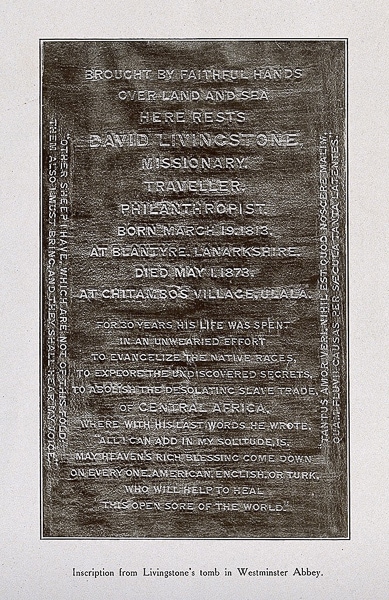
After Livingstone’s death, his body was transported to London for burial in the nave of Westminster Abbey. His gravestone has a long inscription in brass letters that summarizes his life’s work in Africa.
Neville Chamberlain
Burial: Nave
Neville Chamberlain was elected Prime Minister of the United Kingdom in 1937, previously serving as Minister of Health and Chancellor of the Exchequer. Due to poor health, he resigned in 1940 after leading the country through the first eight months of World War II. He died six months later.
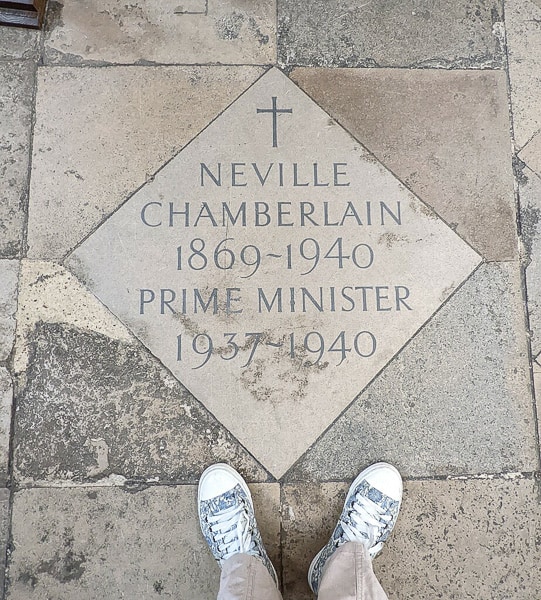
Chamberlain’s funeral took place at Westminster Abbey and his ashes were interred in the nave. The stone over his grave is inscribed with his dates of birth and death and the dates he served as Prime Minister.
Final Thoughts
Exploring the famous graves in Westminster Abbey is an interesting journey through history and culture. From literary giants like Charles Dickens to scientific pioneers like Sir Isaac Newton, each tombstone and monument tells a unique story of human achievement and legacy. Walking through this iconic abbey, one can’t help but feel a sense of reverence for the individuals who have shaped our world in profound ways.
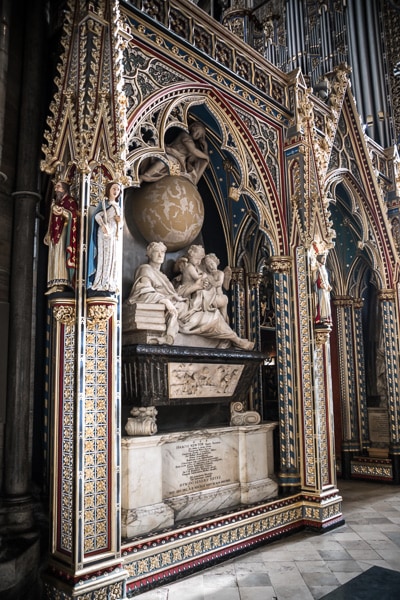
Practical Information for Visiting Westminster Abbey
Location: Westminster Abbey is located in London at 20 Dean’s Yard.
Hours: Westminster Abbey is open Monday to Friday from 9:30 am- 4:30 pm (last entry 3:30 pm), Saturday from 9:00 am- 4:00 pm (last entry 3:00 pm), and Sunday for services. Confirm current hours here.
Admission Fees: Yes
Tours: A multimedia guide is included in the price of admission so you can do a self-guided tour of the abbey at your own pace.
- Guided tours, led by the abbey’s vergers, are available for an extra fee and let you see parts of the abbey not accessible to general visitors.
- Tours by private companies and guides can be booked online here.
Buy Tickets: Entrance tickets can be bought on the Westminster Abbey website (non-refundable) or online here (refundable).
Accommodations in London
If you’re planning to visit Westminster Abbey and need accommodations, here is a list of hotels in London. Please consider booking your London accommodations through the included link. It costs nothing extra and helps support this website.
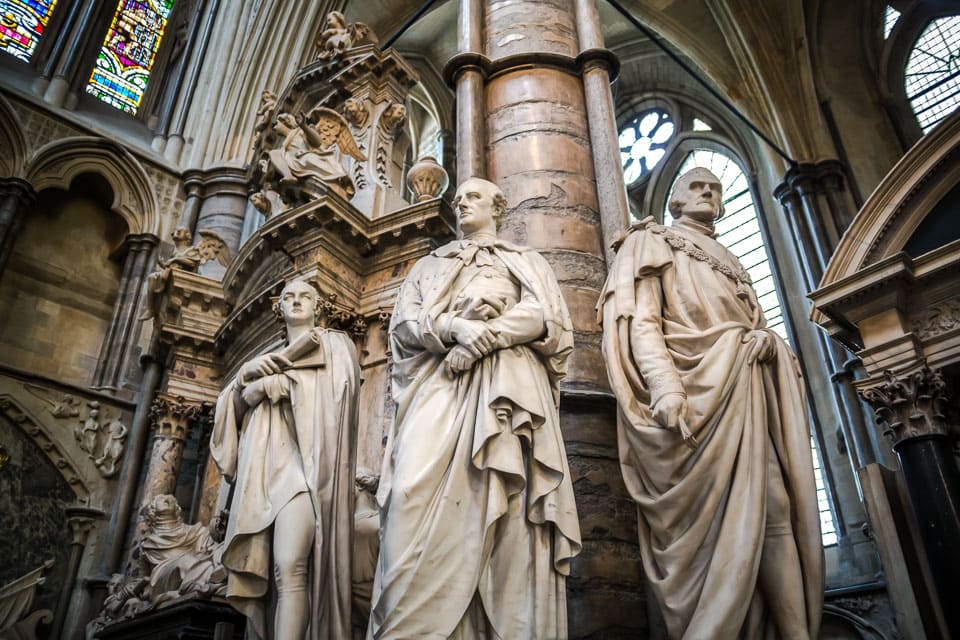
More Burial Places in the U.K. and Overseas Territories
- The Magnificent Seven Cemeteries- Victorian Cemeteries in London
- Highgate Cemetery Burials- Famous Graves in Highgate Cemetery
- Shakespeare’s Grave and Funerary Monument- Discover Shakespeare’s Burial Place in Stratford-upon-Avon
- Grytviken Cemetery- Site of Ernest Shackleton’s Grave
